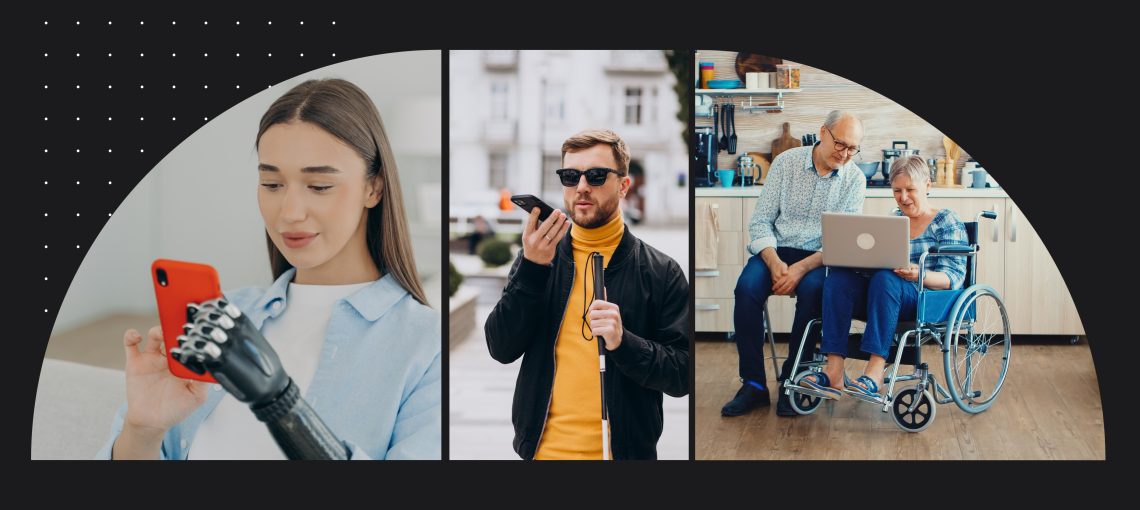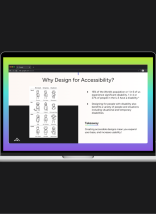Your probably do not have an accessible website
Making your website accessible to all users is more important than ever. Despite this, over 96% of the world’s top one million web pages fall short of website accessibility standards, leaving a significant portion of the global population unable to fully engage with online content. Creating inclusive online environments is not just a moral obligation but also a legal requirement in many regions. In 2024, the new European Accessibility Act (EAA) and the Web Content Accessibility Guidelines (WCAG) 2.2 updates set the standards for making digital content accessible. By embracing website accessibility, you can enhance usability, expand your user base, and comply with international regulations.
Why make your website accessible?
Designing for accessibility isn’t just about compliance; it’s about inclusivity and ensuring that everyone can use and benefit from your website. According to the World Health Organization, 16% of the world’s population, or 1 in 6 people, experience significant disability. In the United States, the Centers for Disease Control and Prevention (CDC) reports that 1 in 4 people, or 27%, have a disability. Given these statistics, it’s clear that accessibility is a critical consideration.
Everyone will experience a temporary or permanent disability at some point in their life. Whether it’s a broken arm, age-related impairments, or situational disabilities like a noisy environment, designing for website accessibility ensures that your website remains usable for a wide range of users.
Key Takeaway: Creating accessible designs means you expand your user base and increase usability for everyone!
Who needs an accessible website under the law?
In the United States, the Americans with Disabilities Act (ADA) mandates that state and local governments must be accessible under Title I. Additionally, any business open to the public must comply under Title III. This includes a wide range of entities:
- State and Local Government: All government websites and digital services must be accessible.
- Private companies funded by the government: These entities are required to ensure their digital presence is accessible.
- Airlines: The Department of Transportation Rule #2 requires airline websites and automated kiosks at U.S. airports to be accessible to passengers with disabilities.
- Universities: The ADA mandates that educational institutions provide equal access to their programs, services, and activities for students, faculty and visitors with disabilities. This includes making college websites user-friendly so everyone can access essential information and resources without barriers.
Websites are increasingly becoming accepted as public spaces, and thus, must be accessible to comply with the ADA.. Public websites may include those for:
- Retail
- Restaurants
- Hotels, Inns, and Motels
- Hospitals and Medical Offices
- Banks
- Theaters and Sports Arenas
European Accessibility Act (EAA)

The European Accessibility Act (EAA) is a significant piece of legislation that aims to improve website accessibility and of a wide range of products and services within the European Union. Compliance enforcement begins on June 28th, 2025. The EAA sets clear guidelines and standards that must be met, ensuring that digital services are accessible to everyone, including those with disabilities.
The European Accessibility Act Applies to the following products and services within the European Union:
- E-Commerce – Any E-commerce that sells to anyone in the EU
- Hardware and software products brought the market after June 2025
- Computers, smart phones, ATMs television equipments, E-Readers, ticketing and check-in machines
- Banking
- Telecommunications
- Transport services
- Audio-visual media services
Exceptions
- Published before June 2025
- Any 3rd party content that you don’t have control over
Non-Compliance
- Financial and Legal penalties
- B2B procurement: UPAT
- Monetary fines
- Reputational Damage
Compliance Standards
- WCAG 2.2 Level AA
- European Standard (EN 301 549)
WCAG 2.2 Updates
WCAG is a set of guidelines developed by the World Wide Web Consortium (W3C) to ensure web content is accessible to people with disabilities.
WCAG 2.2 introduced several new success criteria in October of 2023 aimed at enhancing accessibility. WCAG 2.2 added personas to the success criterion in order to better empathize with the needs of the users.
To maintain an accessible website in 2024, you need to ensure your website follows all of the WCAG 2.1 Level A & AA guidelines as well as the new WCAG 2.2 updates. These updates include:
Focus Not Obscured (Minimum) – Level AA
When a user interface receives keyboard focus the component is not hidden due to author-created content.
“This page has a big banner that’s always across the bottom. (a sticky footer) When I move focus to items, some are hidden behind the banner and I can’t see them”
– Persona Alex, a reporter with repetitive stress injury
Dragging Movements – Level AA
All functionality that uses a dragging movement for operation can be achieved by a single pointer without dragging unless dragging is essential.
ex, a map allows users to drag the view of the map around, and the map has up/down/left/right buttons to move the view as well.
“I cannot hold down the mouse button and drag it accurately enough to move the items in the list.”
-Persona Yun, a retiree with hand tremor
Target Size (Minimum) – Level AA
The minimum size for any target should be 24px by 24px
“The buttons are so close, I hit “Cancel” when going for “Submit”. Then I have to start all over again.”
– Persona Yun, a retiree with hand tremor
Consistent Help – Level A
Put help in the same place when it is on multiple pages.
“Whenever I use the online app to schedule my medical appointments, I can’t remember what to do at each step. I’ve seen a chat option in some places, but can’t find it now”
– Persona Luis, a supermarket assistant with cognitive disabilities
Redundant Entry – Level A
Information previously entered by or provided to the user that is required to be entered again in the same process is either auto-populated, or available for the user to select.
“Whenever I use the online app to schedule my medical appointments, I have to re-type some information that I entered in a previous step.”
-Persona Luis, a supermarket assistant with cognitive disabilities
Accessible Authentication (minimum) – Level AA
Don’t make people solve, recall, or transcribe something to log in.
“I can never remember my password, it’s really hard to get into this app.”
-Persona Luis, a supermarket assistant with cognitive disabilities
How to ensure your website is accessible
To ensure your website is accessible, follow these steps:
- Conduct an Accessibility Audit: Evaluate your current website against WCAG 2.2 standards to identify areas that need improvement.You can use a scanner like RocketValidator.
- Implement Necessary Changes: Make the required updates to meet accessibility guidelines. This may include adjusting contrast ratios, ensuring keyboard navigability, and providing text alternatives for non-text content.
- Use Accessible Design Practices: From the start of the design process, incorporate accessible design principles to ensure all new content is compliant.
- Test with Real Users: Conduct usability testing with individuals who have disabilities to get direct feedback on your website’s accessibility.
- Keep Up with Updates: Accessibility standards and technologies evolve. Stay informed about the latest updates to WCAG and other relevant guidelines.
By proactively addressing accessibility, you not only comply with legal requirements but also create a more inclusive and user-friendly experience for all visitors to your website.Ready to make your website accessible? Contact Atlantic BT today to ensure your digital content meets the latest accessibility standards and provides a seamless experience for all users.







